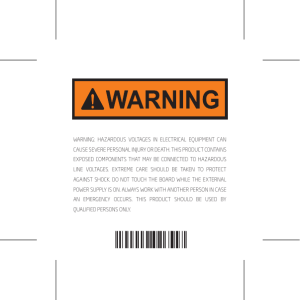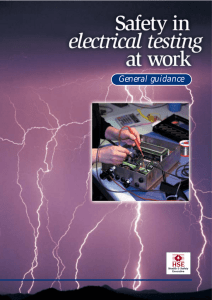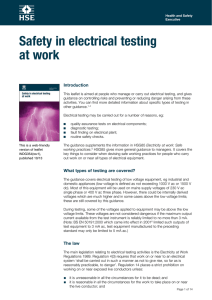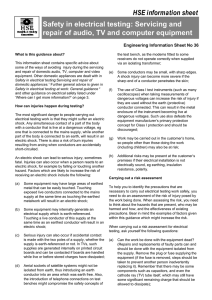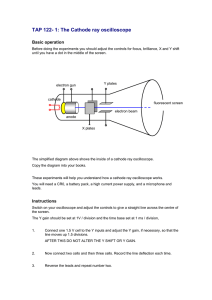Safety in electrical testing at work - general guidance
advertisement
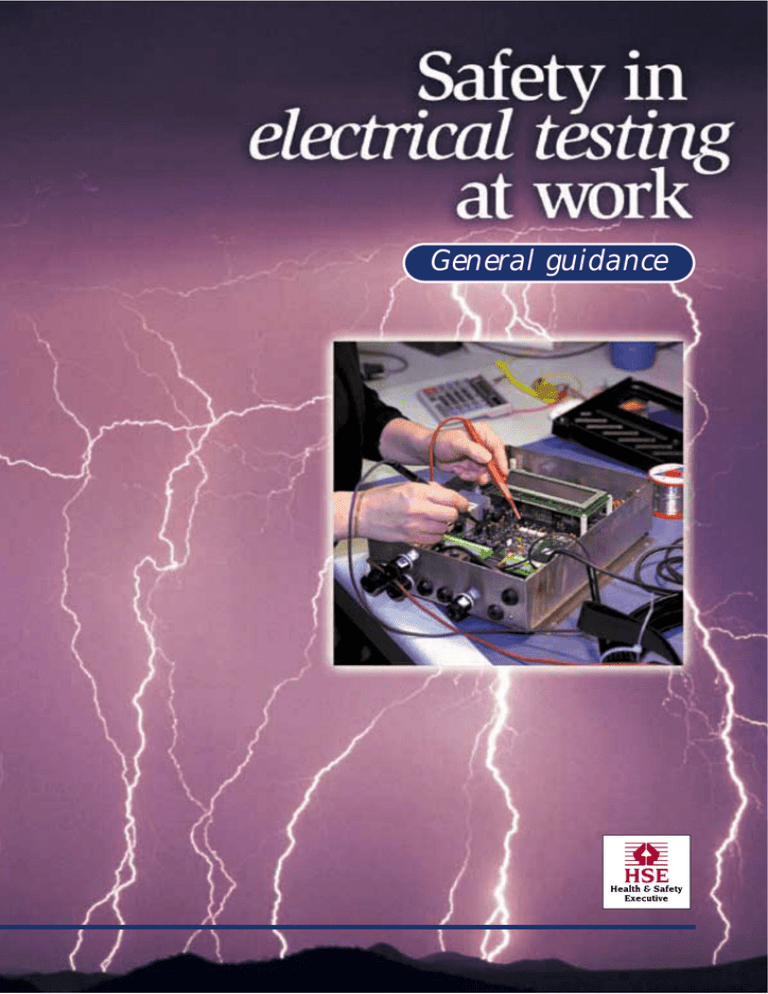
General guidance 1 Safety in electrical testing at work What is this guidance about? This booklet provides basic guidance on safe electrical testing and is intended for anyone who runs or manages a workplace where electrical testing is carried out, and for those people doing the actual testing. It is complemented by information sheets which give more detailed information about specific types of testing.1–4 Electrical testing may be carried out for a number of reasons, for example: (a) quality assurance tests on electrical components; (b) diagnostic testing; (c) fault-finding on electrical plant; (d) routine safety checks. The guidance contains recommendations to help you prevent or reduce electrical danger. Some of the main ways in which this can be done include: (a) following safe systems of work, for example: (i) taking precautions to prevent people who are not doing the testing coming into contact with exposed live parts; (ii) taking precautions to prevent the testers coming into accidental contact with exposed live parts; (iii)protecting and insulating both the 2 equipment being worked on and the testing equipment. (b) using test equipment that is suitable for the job; (c) making sure that people doing the work are suitably trained and experienced so that they understand safe working practices and the equipment on which they will be working. What types of testing are covered? This guidance covers electrical testing in situations (mostly low voltage, ie not exceeding 1000 V ac or 1500 V dc) where equipment like domestic appliances is being tested. Most of this equipment will be used on mains supply voltages of 230 V ac single phase and 400 V ac three phase. However, there could be internally derived voltages which are much higher and in some cases above the low voltage limits. Some of the test voltages applied to equipment during testing may be above the low voltage limits. These voltages are not considered dangerous if the maximum output current available from the test instrument is reliably limited to no more 5 mA (traditionally 5 mA ac has been used, but since May 20015 new equipment should be limited to 3 mA ac). Safety in electrical testing at work What is the risk of injury? Injury can occur when live electrical parts are exposed and can be touched, or when metalwork which is meant to be earthed becomes live at a dangerous voltage. The likelihood of touching live parts is increased during electrical testing and fault-finding, when conductors at dangerous voltages are often exposed. This risk can be minimised if testing is done while the equipment is isolated from any dangerous source of supply, although this cannot always be done, and care must also be taken to prevent contact with any hazardous internally produced voltages. The most dangerous injuries are those caused by electric shock. This is because the effects of a shock are largely unpredictable and can easily lead to a fatal injury. However, there is also a risk of burn injuries resulting from arcing when conductors are accidentally short-circuited. A secondary risk can be the harm caused by a person reacting to an electrical injury, for example by falling or being traumatised by the experience. Electric shocks occur when contact with a live conductor causes sufficient current to pass through the body to cause an injury. As a rough guide, voltages exceeding 50 V ac or 120 V ripple free dc should be considered hazardous in a dry, unconfined, non-conductive location. These voltage values must be reduced if the location is wet, confined or conductive, so where there is an adverse environment, those in charge of the work and those doing the work should be aware of the probable increase in injury risk. In some equipment, for example microwave ovens, high voltages of several thousand volts are used and there is a very high risk of fatal injury if the exposed conductors are touched at these voltages. Injury may also be caused by currents as low as 5 mA or by stored charges. Suitable precautions must be taken to prevent contact with stored charges in excess of 350 mJ. If the skin is pricked or cut at the point of contact, the shock current (and hence the seriousness of the injury) will be higher. Healthy skin may also become damaged at the time of contact either by the burning effect of the current or by penetration from sharp-ended conductors. Carrying out a risk assessment As well as the level of voltage, charge or current and the nature of the environment, there are a number of other factors that need to be considered when you are assessing the risk of injury arising from electrical testing work. A risk assessment should be carried out before testing begins, to help you identify the precautions you need to take. Some questions to ask when carrying out the risk assessment are: (a) Can the work be done with the equipment dead or energised at a safe voltage or current? (b) Is it absolutely necessary for someone to be working on or near to equipment that is live at dangerous voltages or current levels? (c) What is the maximum voltage on conductors that will be exposed during the work activity? (d) Are the testers competent? Are they adequately trained and knowledgeable to do the particular work and ensure that others are not put at risk? (e) If testers are not considered fully competent, are they adequately supervised? (f) What physical safeguards should be applied to the equipment under test to prevent injury, eg the use of temporary or permanent screens? (g) Is the test instrumentation of safe design? Has it been properly maintained? (h) Is it necessary to set up a permanent test area separate from the rest of the workplace, 3 Safety in electrical testing at work where equipment can be taken for testing? Is it necessary to set up a temporary test area around the equipment? (i) Are the testers able to supervise the working area sufficiently and at all times to prevent danger to others? (j) Where testing is part of an ‘after sales service’ how much must be done at customers’ premises? If testing is being done in a customer’s home, what special precautions are required to protect the tester and others? (k) To what extent should the testers be supervised or accompanied? (l) If the testers design, manufacture or use any special test equipment, does it meet BS EN 61010-1?6 (m) How big is the unit under test and how much space is required around it to undertake the testing in a safe and unconfined manner? (n) Are all the other workshop employees competent to avoid danger if there is a need for them to approach the equipment? If not, how can you make sure that they do not do so? (o) Will the equipment be left unattended while live, for example while being ‘soak tested’? (p) Does the workbench or separate area require a warning, eg a light, to show that testing is in progress? (q) Is there a need for additional emergency switching devices for use by other employees to reduce the degree of injury to testers? Can residual current devices (RCDs) be used to provide supplementary protection? (NB: This guidance and the complementary information sheets1–4 refer to RCDs or 30 mA RCDs. See the section relating to residual current devices on page 9 for a fuller explanation.) (r) Is it possible to reduce the number of available paths to earth to reduce the likelihood of a phase-to-earth shock, eg by the use of barriers, screens and insulating mats? (s) Is it possible to use unreferenced supplies, eg isolating transformers/batteries to reduce the likelihood of a phase-to-earth shock? 4 Managing electrical testing You must provide a safe working environment and establish a safe system of work for your employees. The results of your risk assessment will help to identify the steps you need to take to do this. Employees must co-operate and take reasonable care for their own and other people’s safety while they are at work. The following advice needs to be considered for all activities involving testing. Personnel All personnel must: (a) understand that the risk of electric shock injury will still remain during the testing process, even with the use of earth-free test areas and/or isolating transformers and/or RCDs; (b) fully understand the scenarios in which these electric shock injury risks can arise in the particular workplace(s); (c) be given adequate first-aid training, including cardiac pulmonary resuscitation (CPR) skills. Permanent test areas These areas must: (a) be under the control of a responsible person; (b) be in an area set apart by barriers to prevent entry; (c) have suitable warnings provided at the entrance; (d) be accessible during testing only to authorised staff or people working under their direct supervision; (e) have suitable warning lights indicating that testing is in progress and other warning lights to indicate when it is safe to enter the area (duplicate red and green lights are often used); (f) have emergency-stop push buttons or equally effective means to cut all test Safety in electrical testing at work supplies in the event of emergency. These emergency controls should be prominently identified. (NB: The emergency controls should not remove supplies to the general lighting in the area.) (g) display an electric shock poster, eg Electric shock: First-aid procedures,7 at prominent locations, showing emergency arrangements, especially telephone numbers; (h) have good housekeeping arrangements, including adequate clear working space. Temporary test areas In some situations it may not be practicable or desirable to remove equipment to a permanent test area, eg because the equipment is too large for the test bay or is located at the customer’s premises. If live testing needs to be carried out, a temporary test area should be set up around the equipment. When setting up a temporary test area, all the precautions listed above for permanent test areas should be taken, unless it is not practicable to do so, in which case an assessment needs to be made of what precautions are needed to reduce that risk to as low a level as possible. Remember that simple ‘Go/No go’ plug-in testers will in general only provide a polarity check and an indication that an earth may be present, but not its effectiveness. Earth-free areas: Make a test area as earth free as possible, in conjunction with the use of isolated supplies. To achieve this, take the following precautions: (a) use a test bench made of insulating material with shrouded legs and framework to prevent the possibility of contact with earth while testing; (b) remove all pipes, radiators, structural steelwork, metal conduits, earthed electrical appliances, metallic socket outlets etc from within reach of the test bench, or permanently shroud them with insulating material to prevent contact; (c) where soldering irons and task lighting are needed, they should be extra low voltage, supplied from an isolating transformer complying with BS 615588 to prevent the need for earthed metal at the test area; (d) if a television or radio aerial socket is needed at the test area, this should be of isolated construction complying with BS 415;9 (e) insulating rubber matting complying with BS 92110 should be provided on the floor, kept clean and dry, and regularly tested, and should be large enough for the test operative to remain on it whether standing or seated during testing (NB: Chair legs may damage the matting.); (f) if electrostatic discharge wrist straps are provided, these must incorporate a suitable resistance (say 1 Megohm or more). The use of a wrist strap which directly connects the wearer to earth is not permissible. For further advice see BS IEC 61340-5-1: 1998.11 Supplies to equipment under test Each item of equipment under test should be provided with its own test supply. These supplies should be from designated sockets or terminals 5 Safety in electrical testing at work provided with covers interlocked with the supply isolator. The supplies should have suitable system protection against overload and overcurrent in the event of faults, eg fuses. Note that: (a) where an isolating transformer is used for the supply to the equipment under test this should comply with BS 615588 and a separate transformer should be used at every test bench. If this is not reasonably practicable, the same isolating transformer may be used for supplies to alternate benches, provided the risk of referencing this supply to earth at any bench is properly controlled and the transformer does not then have an unacceptably high leakage current; (b) the supply from the isolating transformer should be provided from a single socket outlet and clearly marked ‘only for use for making live equipment under test’. No fixed wiring should be connected to the earth terminal of the outlet socket. The face plate of the socket should be made of insulating material. There must be no unnecessarily exposed live parts on equipment under test; (c) in certain circumstances Class I equipment under test must be effectively earthed unless supplied via an isolating transformer. This will bring with it an increased risk of electric shock which may be minimised by the use of other precautions. (d) when the equipment under test is Class I, any pre-existing earth fault must be detected and corrected before making the equipment live. In the case of the supply from an isolating transformer, failure to do this will mean that there may be a hazardous shock risk in the event of a simultaneous contact between the enclosure of the equipment and one or both poles of the isolated test supply; (e) the integrity of the circuit protective conductor (earth) of all portable/transportable Class I equipment must be re-tested after all test-bench work has been completed, to ensure that no earth faults are present before the equipment is used again on a normal mains supply. 6 Risk assessment – test equipment and electricity supplies All measures used to control risk of electric shock should follow the hierarchy given below: (a) first and foremost, control as many of the risks as possible by hardware methods; (b) secondly, control all other foreseeable risks by the use of safe systems of work. These must be made known to and fully understood by all staff involved, regularly monitored, and recorded in written form (for reference and to permit refinement or amendment as and when needed); and (c) finally, use of competent staff who must possess the necessary level of technical knowledge and experience (or be supervised by a competent person) to prevent risk of injury. If the hardware precautions resulting from the risk assessment include the provision of isolating transformers for the source of supply to mainspowered test equipment, then such provision should normally be made and the isolation transformer should be separate from the equipment under test. An instrument shelf should be provided for that equipment. Some of the risks associated with the use of test equipment can be reduced, but not eliminated by placing all test equipment on an insulated shelf immediately above the test bench. This will reduce the chance of simultaneous contact between the test equipment and the equipment under test. When the hardware precautions resulting from the risk assessment do not include the provision of isolated supplies to the mains-powered test equipment, all supplies to test equipment should be protected by 30 mA RCDs. NB: For supplies in excess of 16 A to equipment under test or where the equipment under test has a high leakage current it may not be practicable to use an RCD because of nuisance tripping. For further advice see Section 607 BS 7671.12 Safety in electrical testing at work Setting up safe test areas It is important to make sure that anyone not involved with electrical testing work is kept free from risk. This can be done by confining testing work to a designated test area. In some workshops, it might be possible to set up a permanent workbench and test area, to which only the testers have access. Otherwise, unauthorised people should be prevented from approaching the equipment under test by physical barriers or other demarcation methods which form part of the test area boundary. A test area can be: (a) a designated room built as a test area with special protection features and fitted with secure doors (possibly interlocked, depending upon the degree of risk) to prevent unauthorised access; (b) an area set aside in a workshop with some form of permanent barrier as a demarcation; (c) a work bench which might be designed as a test bench or be used for repairs and testing; (d) a designated work position within, or at the end of, a production line; (e) a temporary area set up around equipment using purpose-built barriers as demarcation; (f) an area around fixed equipment, such as switchgear, or control gear, where skilled people are carrying out repairs, fault-finding or testing during maintenance work. In workshops where all employees have been adequately trained and instructed in safety practices and all unauthorised personnel are effectively excluded, local demarcation of the workbench or work area where testing is done may not be necessary. All employees need to be aware that those who are carrying out testing should not be distracted by the interference of others who are not involved with the test in progress. Protecting the people doing the testing The measures that are used to protect the people doing the testing need to be effective to prevent them coming into accidental contact with dangerous exposed conductors. This might be either a single-hand contact with a source of energy which has one of its supply conductors 7 Safety in electrical testing at work connected to earth, or another area of conducting surface. Class I equipment is in this category because the mains at source are earth referenced; so is electronic equipment where a large metal surface (or chassis) is connected to the source. There is also a risk of injury from sources of supply which are not earth referenced and where accidental simultaneous contact with both poles of the supply is possible. Methods of reducing the risk of a shock from simultaneous contact with conductors include: (a) testing at reduced, non-hazardous voltages and currents; (b) using interlocked test enclosures in which the unit under test is contained; (c) using temporary insulation; (d) replacing covers which need not be removed for the purposes of the test, for example once supply connections have been made; (e) creating an area which is as earth free as practicable; (f) using isolating transformers connected to the mains supply; (g) using 30 mA RCDs. The following sections provide more detail about each of these protective measures. Safe voltages and currents It may be possible to test the equipment by energising it with non-hazardous voltages and current levels. This should always be considered as the first option before deciding to use dangerous voltages and current levels. Interlocked enclosures These can vary in size from a small benchmounted box with an interlocked hinged lid to a large enclosure (large enough for people to enter) equipped with access gates which are secured by interlocks. It is important to ensure that the safety performance of the interlocking system is comparable with that of a switching 8 device used for isolation purposes. The use of a trapped key (key exchange) system interlocked with the access and the isolator can assist. In general, interlocking using the control system alone is not acceptable; the power supply should be isolated by the interlock system. In certain circumstances there may be the potential for a stored charge to occur, eg from the use of capacitors. In these circumstances the supply to the equipment under test should be earthed, preferably automatically, before entry is made. If it is not possible to earth the equipment automatically, it should be manually earthed by the use of a suitably insulated earthing tool. Where automatic earthing is used, it is essential to use, in addition, a manual earthing device before making contact with any parts that have previously been made live. Where large enclosures are used, you must make sure that people cannot be inside the enclosure while there is danger from the equipment being tested. Safety in electrical testing at work Temporary insulation Where there is risk from simultaneous contact with hazardous conductors, do not assume that employees will be able to avoid accidental contact. Consider using temporary insulation which may be in the form of purpose-made screens or insulating sheets or shrouding (rigid or flexible). However, there may be a practical limit on the use of screens when testing compact electronic assemblies. Earth-free areas It is difficult to achieve a true earth-free area, since there is a need to ensure that floors and walls will not conduct current which can give rise to shock injury. Suitable insulating materials, including mats, are therefore needed to construct an earth-free area. These parts will then have to be tested at regular intervals to demonstrate that their insulation properties are being maintained. An area which is as earth free as practicable can be more easily created, but a thorough risk assessment needs to be done to ensure that the testers will not make accidental contact with any earthed conductors. Items such as heating and water pipes and radiators should be enclosed, or the test area should be situated to prevent simultaneous contact by the tester with the item under test and the earthed item. Earthfree areas should have the minimum of exposure of conductive parts. A 30 mA RCD could be used as supplementary protection. Earth-free areas are often used in conjunction with isolating transformers. Where it is not possible to make an area earth free because it is necessary for the test equipment and/or the equipment under test to be earthed, it is still possible to reduce the extent of the accessible earthed metalwork. Isolating transformers Isolating transformers connected in the test supply will prevent the risk of electric shock if a person touches a single live conductor of the isolated supply while in contact with an earthed conductor. It should be clearly understood, however, that an isolating transformer cannot prevent an electric shock if someone makes contact simultaneously with both conductors of the supply on the secondary side of the transformer, unless the output voltage is below 50 V ac (120 V dc) in dry conditions and 16 V ac (35 V dc) in wet conditions.13 The integrity of the isolation from earth should be tested regularly, or earth fault monitoring devices should be installed, to ensure that dangerous earth faults are detected. Residual current devices (RCDs) These are supplementary protection devices which do not prevent an electric shock, but are able to limit the duration of some shocks by being able to cause rapid disconnection of the electricity supply in the event of a relatively low current flowing to earth, such as may occur during an electric shock. They are, therefore, able to provide a much higher level of protection against the risk of a severe electric shock than could be provided from an unprotected source. An RCD required to minimise the risk of personal injury should have a rated tripping current of no more than 30 mA and should not have an adjustable time delay. Although the 30 mA versions are often used, those with lower rated tripping currents (typically, 10 mA or below) are readily available and may be used to provide additional protection where nuisance tripping is not a problem. Where personal safety depends in part upon the operation of an RCD, the RCD must be tested using the built-in test facility at appropriate intervals (eg portable RCDs before each use, fixed RCDs weekly). In addition, all RCDs 9 Safety in electrical testing at work measurements that can be made by the oscilloscope. A technique has been developed to ‘float’ the oscilloscope (ie remove the connection to the supply protective conductor) which then allows the oscilloscope’s enclosure to float above earth potential (which could be at high voltages for some types of measurement) with obvious possible shock risks. Operation of an oscilloscope with the protective conductor removed means that it is no longer protected against internal insulation breakdown. Another disadvantage with this situation is that it will then be necessary to attempt to create an earthfree area. Such use also defeats the equipment manufacturer’s primary protection concept for Class I protection and should be discouraged. A number of methods have been developed to allow floating measurements to be made more safely. One method is to supply the oscilloscope via an isolation transformer, so removing the earth reference in the supply and allowing floating measurements. The advantage of this method was that an earth-free area is not required but the disadvantage is that the oscilloscope is not protected against internal insulation breakdown to the chassis. (The oscilloscope’s internal insulation could be over-stressed if high-voltage measurements are being taken.) A second method is to use a proprietary isolation monitor (sometimes called a line isolation monitor or an earth (ground) isolation monitor) in the supply to the oscilloscope. This allows the oscilloscope to operate with its protective conductor disconnected but the monitor continuously checks the voltage between the oscilloscope’s enclosure and the supply earth. If the oscilloscope’s enclosure reaches a hazardous voltage, the monitor removes the mains supply to the oscilloscope and usually reconnects the supply protective conductor. A typical operational setting for a monitor would be about 30 volts RMS. The oscilloscope would still be protected against internal insulation breakdown. The disadvantage is that it can only be used to measure low-level signals because the oscilloscope’s internal insulation could otherwise be over-stressed. In recent years, developments have led to various devices that can be used in an oscilloscope’s measuring probes which allow the Class I oscilloscope to be earthed to the mains supply, but which isolate the measured voltages to prevent them appearing on the oscilloscope’s enclosure. Modern proprietary devices use various techniques to achieve isolation (eg opto-isolators) and typically allow measurements to be made ranging from millivolts to thousands of volts. Bearing in mind the risks involved, such isolators should be regarded as being reasonably practicable safeguards. The isolation devices come in several forms and may have slightly different names, according to the manufacturer. Some of the common names for these devices are: isolation amplifiers; differential amplifiers; and isolation probes. Correct selection of device, according to the measurements to be made, is important. The user should seek the manufacturer’s advice. Some manufacturers now offer oscilloscopes with isolated inputs (ie where the measured inputs are isolated from each other and from the oscilloscope’s chassis), up to reasonably high voltage levels (typically 850 V peak ac and dc). Consideration should be given to the use of these as well as to all-insulated, Class II oscilloscopes. Battery-operated oscilloscopes which can be used up to reasonably highvoltage measurement levels are available. These are not referenced to earth. It is good practice to include an RCD with a rated tripping current of, at most, 30 mA in the power supplies to Class I instruments, soldering irons and any other mains-powered equipment. If isolation transformers are used to supply power to fixed socket outlets as part of a 11 Safety in electrical testing at work distribution system for test supplies, the sockets should be of a different type to standard sockets, or of the polarised type, to ensure they are only used for the purpose intended. Safe systems of work Details of safe systems of work for testing activities should, wherever it is reasonably practicable to do so, be written down. In order to produce a workable system, all personnel should be involved in the preparation of the safe systems of work. The completed documents, which will need to be reviewed from time to time, should be made readily available to employees. Where testing is confined to diagnostic testing on electrical distribution systems and equipment (eg switchgear), by electrically competent persons, the contents of the written documents should cover the essential safe working practices. They may not need to cover the inherent background knowledge of such a competent person (this will of course depend on the experience of the competent person). Test personnel who work in customers’ premises might have to work under different rules, as compared to working at a factorybased test facility. This means that there may need to be two sets of rules. This should be taken into account when producing the safe system of work. The contents of the written safe systems of work should include, as a minimum, details of: (a) who is authorised to undertake testing and, where appropriate, how to access a test area and who should not enter the area; (b) where temporary test areas are constructed, how this is to be done; (c) rules for isolating equipment and how the isolation is secured; (d) the correct use of additional protection measures, for example flexible insulation, that 12 have to be applied to the equipment under test while its covers are removed. If it is considered necessary to apply the insulation and remove covers while the equipment is live, this risk should also be assessed; (e) what form of power supply should be used to energise the equipment under test, particularly where use of the wrong method would compromise safety; (f) what is expected of test personnel regarding the inspection of test equipment before use, and how defects are to be reported; (g) the correct use of any warning devices that form part of the safety system at designated test areas; (h) instructions about what action should be taken in an emergency situation. Training All personnel involved in testing should be given specific safety training relevant to the work they are doing. Appropriate training or instruction must also be given to anyone who may attempt to enter test areas and approach test benches. New training is likely to be necessary whenever any of the following occur: (a) changes to product design, layout and installation; (b) changes to production or working methods; (c) changes to test methods and instruments; (d) changes to test personnel and others who may be affected. Competence of testers In small businesses, skilled electricians or technicians are sometimes employed to look after the day-to-day operation of the electrical systems. If such people are involved in setting up testing arrangements, make sure that they are Safety in electrical testing at work changes to safety procedures that are necessary following discussions with the test personnel. A safety review should be carried out when changes are made that may affect testing work, such as changes in production methods, supply arrangements, test methods and instruments, or when personnel changes are made. aware of all aspects of safety relating to testing. Specialist competent advice may be needed to ensure that the testing procedure is safe. When setting up a testing area, it is important that people who are electrically unskilled or inexperienced are protected from electrical danger at all times. Appropriate precautions will also need to be taken to prevent injury of people who have electrical knowledge and skills. Remember that even a skilled person can make accidental contact with dangerous electrical conductors if they are not protected. Someone’s personal electrical competence should not be relied on as their main protective measure. The precautions that are taken should be reviewed regularly, to make sure that they are being followed and are still appropriate for the work that is being done. As part of this safety review, employees should be given sufficient instruction and training on how the safe working procedures have been amended. This is especially important where there is a change in design of products being tested which is relevant to how the protection concepts are applied. It is good practice to give one person the task of reviewing designs and implementing any Where testing is done by a contractor invited to a site, safe working arrangements must be discussed and agreed before the work starts, preferably at the contract discussion stage. This enables everyone concerned to know who is doing what and who is responsible for what, so that the work can be done safely and without risk to the contractor’s employees, the site employees and others who might be affected. In particular, the person who is responsible for the safe isolation and state of the equipment should be identified and agreed. Legal requirements The Electricity at Work Regulations 1989 are the principal legislation relating to electrical testing activities. Regulation 4(3) requires that ‘work on or near to an electrical system shall be carried out in such a manner as not to give rise, so far as is reasonably practicable, to danger’. Regulation 14 places a strict prohibition on working on or near live conductors unless: (a) it is unreasonable for the equipment to be dead; (b) it is reasonable for the work to take place on or near the live conductor; and (c) suitable precautions have been taken to prevent injury. In addition, employers are required under regulation 3 of the Management of Health and Safety at Work Regulations 1999 to assess the risks to the health and safety of their employees while they are at work, in order to identify and implement the necessary precautions to ensure safety. 13 Safety in electrical testing at work References 10 BS 921: 1976 Specification. Rubber mats for electrical purposes 1 Safety in electrical testing: Servicing and repair of domestic appliances Engineering Information Sheet EIS35 HSE Books 2002 11 BS IEC 61340-5-1: 1998 Electrostatics: Protection of electronic devices from electrostatic phenomena. General requirements 2 Safety in electrical testing: Servicing and repair of audio, TV and computer equipment Engineering Information Sheet EIS36 HSE Books 2002 12 BS 7671: 2001 Requirements for electrical installations (IEE Wiring Regulations. Sixteenth edition) 3 Safety in electrical testing: Switchgear and control gear Engineering Information Sheet EIS37 HSE Books 2002 4 Safety in electrical testing: Products on production lines Engineering Information Sheet EIS38 HSE Books 2002 5 BS EN 50191: 2001 Erection and operation of electrical test equipment 6 BS EN 61010-1: 1993 Safety requirements for electrical equipment for measurement, control and laboratory use (full document is in 11 parts) 7 Electric shock: First-aid procedures HSE Books 2002 ISBN 0 7176 2264 9 13 BS PD 6536: 1992 Extra-low voltage (ELV) limit values Further reading HSE publications Memorandum of guidance on the Electricity at Work Regulations 1989. Guidance on Regulations HSR25 HSE Books 1989 ISBN 0 7176 1602 9 Safe use of work equipment. Provision and Use of Work Equipment Regulations 1998. Approved Code of Practice and guidance L22 (Second edition) HSE Books 1998 ISBN 0 7176 1626 6 8 BS EN 61558-1, -2-1, -2-2, -2-4, -2-6:1998 Safety of power transformers, power supply units and similar. Particular requirements for safety isolating transformers for general use Management of health and safety at work. Management of Health and safety at work Regulations 1999. Approved Code of Practice and guidance L21 (Second edition) HSE Books 1999 ISBN 0 7176 2488 9 9 BS 415: 1990 Specification for safety requirements for mains-operated electronic and related apparatus for household and similar general use Maintaining portable and transportable electrical equipment HSG107 1994 ISBN 0 7176 0715 1 14 Safety in electrical testing at work Electrical test equipment for use by electricians GS38 1995 ISBN 0 7176 0845 X Electricity at work: Safe working practices HSG85 ISBN 0 7176 0442 X Other publications A design guide for the electrical safety of instruments, instrument/control panels and control systems (Ref 178) Engineering Equipment and Material Users’ Association (EEMUA), 14-51 Belgrave Square, London SW1X 8PS Tel: 020 7496 8990 ISBN 0 85931 080 9 DASA Quality criteria (Section 2 ‘Competence’ and 3.1 ‘Electrical Safety Tests’) Domestic Appliance Service Association (DASA), 6-9 The Maltings, Stanstead Abbotts, Herts SG12 8HG Tel: 01920 870173 (free) Electrical maintenance: Code of practice The Institution of Electrical Engineers (IEE), Savoy Place, London WC2 R0BL Tel: 020 7240 1871 ISBN 0 8529 6769 1 British and international standards BS EN 61557-1:1997, IEC 6155-1:1997 Electrical safety in low voltage distribution systems up to 1000 V ac and 1500 V dc: Equipment for testing, measuring or monitoring of protective measures. General requirements (full document is in nine parts) BS 3535-2:1990 Isolating transformers and safety isolating transformers. Specification for transformers for reduced system voltage. BS PD 6519 Guide to the effects of current on human beings and livestock. Part 1: General aspects - Guidance on the effects of ac (frequencies between 15 and 100 Hz) and dc. Part 2: Special aspects relating to human beings Guidance on the effects of alternating current and frequencies above 100 Hz, with special waveforms, or in the form of short duration unidirectional single impulses. Part 3: Effects of current passing through the body of livestock. Addresses of trade and professional associations Radio, Electrical and Television Retailers’ Association (RETRA), RETRA House, St. John’s Terrace, 1 Ampthill Street, Bedford MK42 9EY Tel: 01234 269110 Engineering Equipment and Material Users’ Association (EEMUA), 45 Beech Street, London EC2Y 8AD Tel: 020 7496 8990 British Electrotechnical and Allied Manufacturers’ Association (BREAMA) Federation of the Electronics Industry (FEI) Russell Square House, 10/12 Russell Square, London WC1B 5EE Tel: 020 7331 2000 Domestic Appliance Service Association (DASA), 69 The Maltings, Stanstead Abbotts, Hertfordshire SG12 8HG Tel: 01920 870173 Association of Manufacturers of Domestic Electrical Appliances (AMDEA) Rapier House 40-46 Lambs Conduit Street London WC1N 3NW Tel: 020 7405 0666 Institution of Electrical Engineers (IEE), Savoy Place, London WC2 R0BL Tel: 020 7240 1871 While every effort has been made to ensure the accuracy of the references listed in this publication, their future availability cannot be guaranteed. 15 Further information HSE priced and free publications are available by mail order from HSE Books, PO Box 1999, Sudbury, Suffolk CO10 2WA Tel: 01787 881165 Fax: 01787 313995 Website: www.hsebooks.co.uk (HSE priced publications are also available from bookshops.) For information about health and safety ring HSE's InfoLine Tel: 08701 545500 Fax: 02920 859260 e-mail: hseinformationservices@natbrit.com or write to HSE Information Services, Caerphilly Business Park, Caerphilly CF83 3GG. You can also visit HSE’s website: www.hse.gov.uk British Standards are available from BSI Customer Services, 389 Chiswick High Road, London W4 4AL Tel: 020 8996 9001 Fax: 020 8996 7001 Website: www.bsi-global.com This leaflet contains notes on good practice which are not compulsory but which you may find helpful in considering what you need to do. This leaflet is available in priced packs of 5 from HSE Books, ISBN 0 7176 2296 7. Single free copies are also available from HSE Books. This publication may be freely reproduced, except for advertising, endorsement or sales purposes. First published 04/02. Please acknowledge the source as HSE. Printed and published by the Health and Safety Executive 04/02 INDG354 C400 16
